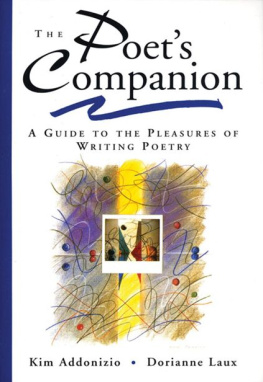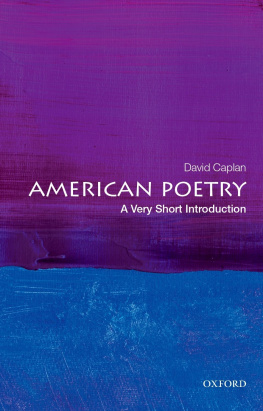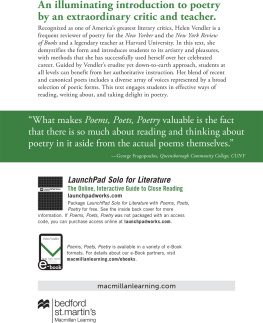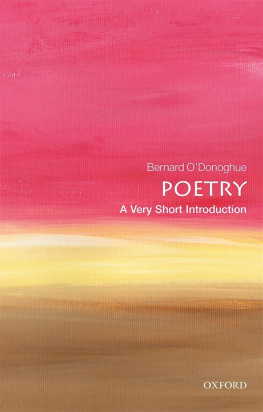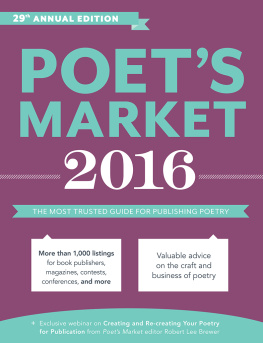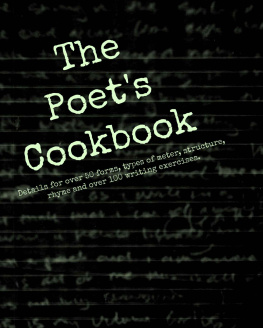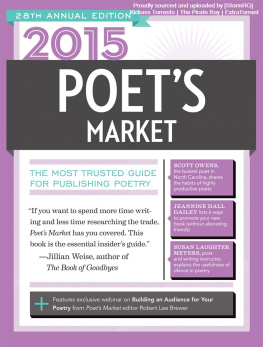We wish to thank our editor, Carol Houck Smith, as well as Anna Karvellas and Fred Courtright, all of Norton, for their help in completing this project. Additional thanks to Villa Montalvo in Saratoga, California, for a residency which enabled us to work together on the book. Were also grateful to Scott Reid for all his helpful e-mails about the Internet. And to Amy Kossow, our wonderful agent, for her persistence and faith.
Introduction
This book grew out of our daily concerns as poets, and out of our work as teachers of poetry. For several years we offered one-day intensive workshops in the San Francisco Bay Area, exploring issues and ideas with all kinds of writers. Additionally, weve taught classes in prisons, community colleges, high schools, at writers conferences, and in university creative writing programs. Our students have been wonderfully varied: carpenters, therapists, waiters, retired persons, housewives and househusbands, photographers, word processors, systems analystsin short, a cross-section of our community. Theyve ranged from absolute beginners to publishing poets with graduate degrees. All of them have had one thing in common: the desire to write poetry, and to do it well.
We wanted to create a book that would focus on both craft and process. Craft provides the tools: knowing how to make a successful metaphor, when to break a line, how to revise and rewritethese are some of the techniques the aspiring poet must master. And the study of craft is lifelong; the exercises offered here should be useful even for experienced poets who want to further hone their skills. Process, the day-to-day struggle to articulate experience, is equally important; so weve devoted a portion of this book to the writing process itself. Within these pages youll find not only a guide to the nuts and bolts of how poems are made, but discussions ranging from how to tackle your subject to how to cope with rejection and self-doubt. Weve also included practical information like how to submit your work for publication and what the Internet has to offer poets; and theres even a chapter on grammar, a subject too often neglected in creative writing classes.
This book can be used in a number of ways. In a semester-long class or workshop, each chapter in Subjects for Writing and The Poets Craft might form the basis for the weeks activities. The Writing Life can offer the student inspiration and information outside of class; further ideas for creating new poems are taken up in Twenty-Minute Writing Exercisesideal when working with a group. If youre reading this book on your own, let it be your teacher, leading you towards new knowledge and enlivening your imagination. Get together with others, if possible, and assign yourselves weekly exercises from the book, and meet to share the results.
We think youll find this an accessible guide to the pleasures of reading and writing poetry. The exercises weve developed have proven to be useful catalysts for the creation of new and interesting work, both for ourselves and our students. The poems weve chosen are ones weve loved and found to be important to our growth as poets and human beings. Weve avoided including poems that are already widely available in many anthologies and textbooks, and we havent included any of the fine world poetry available in translation; instead, this book focuses on contemporary poems by American writers, to introduce you to poetry as it is right now, with its concern for both timeless and timely subjects.
Of course, theres a rich and varied poetic tradition that we hope you are already acquainted with, or will be inspired to seek out. Poet Stanley Kunitz called the tradition of poetry the sacred word the poetry being written in present times he characterized as the living word. Both are important to poets. Its crucial to read whats being written now, to see how the language is changing and evolving; new words enter it daily, while others fall into disuse or take on different meanings. Its important to speak, and listen, to a contemporary community of readers and writers. But its equally crucial to see where the language came from, how it was fashioned and refashioned by poets of the past. To write without any awareness of a tradition you are trying to become a part of would be self-defeating. Every artist alive responds to the history of his or her artborrowing, stealing, rebelling against, and building on what other artists have done. This book is only a small part of the whole. Occasionally, our writing exercises suggest that you read a particular poem, but the poem is not included. We urge you to seek out those poems as models, and we encourage browsing through a particular book or anthology. The appendices to this book include further readings that will involve you more deeply with poems and poetic craft.
Most of all, we hope youll continue to write, to read widely, and to support an art which offers profound rewards, though theyre rarely material. Buy collections of poetry, go to readings, and meet others who feel a similar love of the word. In an age of consumerism and declining literacy, this is more than ever a necessity. William Carlos Williams wrote, It is difficult to get the news from poems, but men die miserably every day for lack of what is found there. And we might add: women, too. We need more poets, not fewer, as some critics of creative writing programs would have it. We invite you to do what Russian novelist Leo Tolstoy asked: to add your light to the sum of light. Do it with patience, and love, and respect for the depth and difficulty of the task. This book is offered in that spirit.
Writing and Knowing
Weve been told again and again to write about what we know, but we dont trust that advice. We think our lives are dull, ordinary, boring. Other people have lives worthy of poetry, but not us. And what are the great poems about? The big subjects: death, desire, the nature of existence. They ask the big questions: Who are we? Why are we here? Where are we going? We find it difficult to believe those subjects, those questions, can be explored and contained in a poem about working at a fast food restaurant, a poem about our best friend, a poem about washing the dishes, tarring the roof, or taking a bus across town. If C. K. Williams had believed this, he might not have written Tar, which is at one level a poem about fixing the roof, and at another, about the end of the world. Carolyn Forch might not have written As Children Together, a poem about her best friend which is also about how we choose one life path over another. In the nineteenth century, John Keats wrote to a nightingale, an urn, a season. Simple, everyday things that he knew. Walt Whitman described the stars, a live oak, a field. Elizabeth Bishop wrote about catching a fish, Wallace Stevens about a Sunday morning, William Carlos Williams about a young housewife and a red wheelbarrow. They began with what they knew, what was at hand, what shimmered around them in the ordinary world. Thats what Al Zolynas did in this poem:

